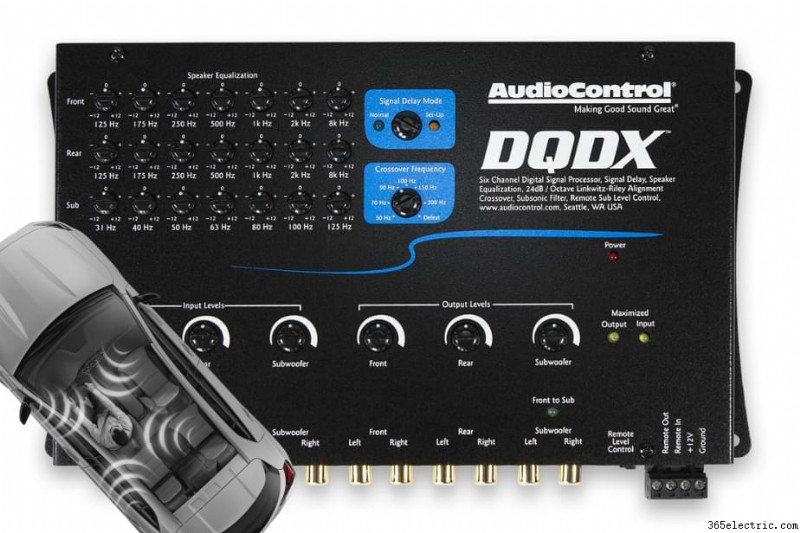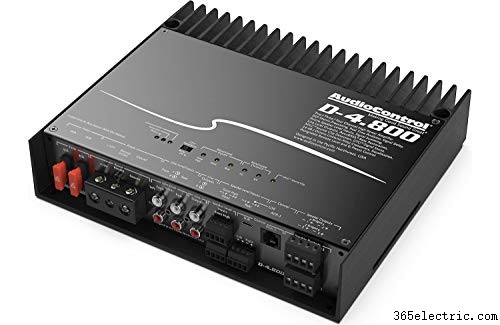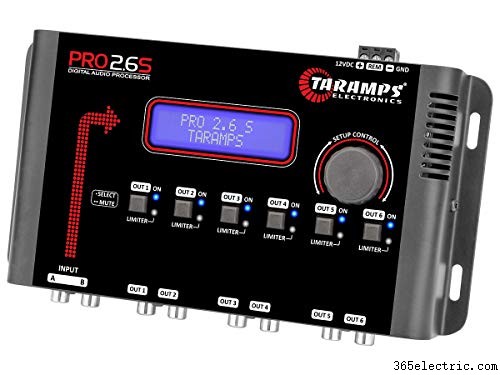Os processadores de sinal digital estão se tornando cada vez mais comuns no mundo moderno do áudio automotivo. Essas unidades parecem ser
vitais para todos os entusiastas , mas eles são amplamente utilizados pela maioria dos amantes da música.
Muitos carros modernos têm um processador de sinal digital integrado, mas muitos não, e isso leva à pergunta:
o que realmente é um DSP no áudio do carro? Um DSP é um processador de sinal digital que pode ser instalado no sistema de áudio de qualquer carro. Um DSP permite uma quantidade incrível de controle sobre o sistema e sua saída. Ele fornece todo o hardware necessário para que um sistema de áudio tenha desempenho e qualidade máximos. Vamos dar uma olhada em
o que é um DSP , se você precisa ou não de um, como configurar um DSP e
qual DSP é o melhor para o dinheiro .
Preciso de um DSP no meu carro?
Usar um DSP em seu carro é uma maneira fantástica de tirar o máximo proveito de qualquer música que você esteja ouvindo,
mas não é um requisito para um sistema de áudio de carro .
Alguns sistemas de áudio automotivo soam muito bem sozinhos, com o EQ integrado na unidade principal usado no sistema sendo
responsável por todos os ajustes de áudio e fazendo o trabalho muito bem.

A necessidade ou não de um DSP em seu carro depende inteiramente das informações abaixo:
- como você pretende usá-lo
- a complexidade do sistema de áudio do seu carro
- quanto controle você deseja ou precisa sobre seu sistema
- seu orçamento
- quanto tempo e esforço você está disposto a gastar pesquisando, instalando e aprendendo a usar um DSP.
Um DSP pode ser necessário para obter o melhor de seu sistema de áudio se a unidade principal instalada em seu carro
não tiver alinhamento de tempo .
O alinhamento de tempo é
um aspecto importante do áudio do carro porque o interior de um carro não é o melhor espaço para ouvir música. Dependendo da forma do carro, você pode ouvir os sons de uma maneira diferente do esperado.
Os sinais de áudio devem ser
enviados pelos alto-falantes no momento certo para tirar o melhor proveito da faixa estéreo que é usada na maioria das gravações modernas.
Quase todas as gravações de músicas modernas são gravadas em estéreo ou surround, mas
isso O efeito
é perdido em um sistema de áudio sem alinhamento de tempo adequado. Ter um DSP é a melhor maneira de aproveitar ao máximo os sinais de áudio enviados pelo sistema de áudio do seu carro.
Dito isto, seu sistema pode soar muito bem sem um DSP, e ter um DSP apenas adiciona ao sistema que você já possui. Adicionar um DSP não fará com que seu sistema soe bem de repente. Ele apenas
oferece mais controle sobre os sinais de áudio do sistema .
Quando usar um DSP no áudio do carro?
- Se você já tem um bom sistema em seu carro e deseja otimizá-lo para seus recursos mais altos possíveis ,
- Se você tiver orçamento e tempo para instalar e aprender o sistema corretamente.
Quando não instalar o DSP no áudio do carro
- Se tudo o que você procura é um sistema de áudio claro e alto para o seu carro.
- Se você não quer ter problemas para otimizar todos os parâmetros do sistema.
- se você for instalar um sistema, configurá-lo e deixá-lo
Uma opção melhor para os cenários acima é instalar um bom EQ.
DSP vale a pena?
Ao encontrar o sistema de áudio automotivo perfeito para você,
é importante considerar exatamente o que você deseja obter do sistema , em vez de apenas comprar os componentes mais caros que você pode pagar.
A instalação ou não de um DSP depende inteiramente de como você deseja que o sistema soe e da
qualidade de sua configuração atual .
Um DSP nunca fará seu sistema soar melhor do que ele pode alcançar por conta própria em termos de desempenho, saída e potência. Um DSP é projetado para permitir que o usuário
ajuste a saída de um sistema de áudio específico em vez de melhorar drasticamente a forma como soa.
Se o seu sistema já tiver a qualidade de áudio que você deseja, adicionar um DSP pode valer a pena para
ajustar e controlar com precisão o sistema você instalou.
Se algumas atualizações de hardware melhorarem a qualidade geral do som do sistema,
adicionar um DSP pode não valer o dinheiro e o esforço , pois não adicionará mais à qualidade do som.
Um DSP permite que você controle com precisão a saída de áudio de todo o sistema, até o EQ exato de cada alto-falante. Isso permitirá que você compense anomalias acústicas no carro,
o alinhamento de tempo e atrasos entre cada alto-falante . Ele extrai o áudio estéreo da melhor qualidade de um sistema.
Um DSP não fará um sistema de áudio de baixa qualidade soar bem, mas
pode ajudar a aperfeiçoar um sistema já de alta qualidade e torná-lo tão bom quanto possível.
Se um DSP vale a pena ou não depende de como seu sistema precisa ser ajustado para soar melhor e
não vale a pena se você precisar atualizar seu sistema primeiro. Os processadores DSP funcionam com rádios de fábrica?
Instalar um DSP em um sistema de áudio automotivo é uma excelente maneira de
melhorar e controlar o sistema .
O rádio de fábrica em muitos carros modernos está
integrado na interface e na navegação do veículo . Isso significa que remover o rádio não é tão simples como era há uma década. Em muitos casos, toda a interface do usuário e o sistema de navegação precisarão ser modificados antes de instalar um novo aparelho de som.
O bom é que a maioria dos rádios automotivos modernos pode receber uma
atualização do processador de sinal digital .
Um DSP geralmente é conectado ao sistema, o que significa que não depende da integração do computador para funcionar e
pode ser instalado com praticamente qualquer rádio de carro padrão de fábrica .
Instalar um DSP com um rádio de fábrica é uma excelente maneira de aproveitar ao máximo o rádio instalado de fábrica
sem modificar todo o sistema ao instalar um rádio de reposição.
A DSP may be integrated into an audio system with a factory radio,
providing greater control of the vehicle’s audio system .
Modern cars have radios installed that are compatible with almost all digital signal processors, but when working with older hardware, you will need to
be sure that the components are compatible with one another .
It is possible to install a digital signal processor with almost every factory radio,
as long as the components will work together .
How to Tune Car Audio DSP for the Best Sound?
Tuning a car audio DSP for the best sound
is a complicated endeavor , and there are many ways and methods that can be used to adjust a DSP.
The most significant factor in tuning a car’s audio digital sound processor is the way it sounds. There are many technical and complicated variables,
but if the audio in your system sounds good to you , then that is all you need.
When you are setting up the system, you do not have to follow the exact formula. If the process that you use to tune the DSP in your system varies from the settings used by your friend, do not worry. Remember that everyone has different requirements, and if your sound system sounds good to you,
you have done well! That being said, here is
an elementary guide for tuning a car audio digital signal processor:
Set the DSP crossovers
The first step is to
set the DSP crossovers . The key here is to try and aim for as flat a response from the crossovers as possible, allowing the system’s sound to be as close to reality as possible.
Set the crossovers at the same frequency between tweeter and mid-range,
aiming as close to 24dB as possible .
Set the time alignment for each speaker
Next, set the time alignment for each speaker
according to the position of your ears when you are sitting in the driver’s seat.
This is not the most straightforward process, but there are
online speaker measurement calculators to make the process much less painful. The best calculator I have found is the
TRACERITE . It is straightforward to use and makes excellent calculations.
Before start, you have to measure the distance from the speakers to the ears. Make measurements when you are in the driver’s seat and input the numbers for every speaker into a calculator.
The calculator will give you the time alignment figures to input into your DSP.
Apply the time alignment settings into the DSP, focusing the audio on
your listening position .
The online calculators have a section that will allow you to shift the central focus of the audio
if you want to move it to the middle of the car or to the passenger seat. Simply add the time delay on each speaker according to where you want the focus center to be.
Use EQ for further adjustments.
The next step in tuning the DSP in your car is to
EQ the system . For this, it is best to use a pink-noise treatment method.
Play a pink-noise treatment track through each isolated speaker, taking measurements with the DSP to
check for any peaking or clipping frequencies .
Cut the undesirable frequencies as you go. Repeat the process for all front speakers individually, then activate all front speakers and play
the track again .
Do the same for the rear speakers and
repeat the process with all of the speakers playing the track simultaneously.
Adjust the EQ according to what you are hearing, and
remove any unpleasant frequencies in the DSP.
Integrate the subwoofer into the system by following the same processes, but
EQ the sub according to the bass frequencies you want to hear , rather than balancing the sub with the rest of the speakers.
This is quite a simple process, and you can do this
by simply listening to the sub and boosting or cutting the frequencies according to what you hear.
Listen to the entire system with the pink-noise track, and then play your favorite system testing song and
make any adjustments that catch your ear .
This is a straightforward setup, and
it is a good starting point to dial in the perfect sounding audio system according to your ears.
Should I Buy A Car Amplifier With Built-in DSP Or A Separate DSP Unit?
Digital signal processing has become much
cheaper to install into amplifiers than analog signal processing and is simpler to install for amplifier manufacturers.
For these reasons, almost every modern amplifier has
some sort of digital signal processor built-in as standard .
However, just because an amplifier has a DSP built-in, it does not mean that it is the best DSP or functions as a DSP. Many cheap modern amps use digital signal processors rather than analog components for ease of use and because they are more cost-effective,
not because they improve the audio system .
For this reason, many people wonder if they should buy an amplifier with an integrated DSP or if they should buy an amplifier with no DSP at all and
instead buy a separate DSP unit .
The answer comes down to your own personal needs and requirements and
what you want the system to do .
If having the control of a DSP is important to you, but you want to save space in your car, and if you don’t mind using whatever DSP the amp manufacturer supplies, then it is worthwhile to buy
a good amp with an excellent integrated DSP . In this case, you will probably end up spending the same money on a separate DSP unit later down the line anyway. The excellent amplifiers with built-in DSP are made by
Audio Control . These products have exceptional quality and offer excellent performance.
I know Audio Control like for example
D-4.800 is not the cheapest one, but if you want to make your car unique with an amazing hi-end system, you should not cut corners, but aim for the top class.

On the other hand, if you want maximum control over your car audio system’s performance, it is better to buy
an amplifier and a DSP as separate units. This setup allows you to choose the exact amplifier and the exact DSP that is
best suited for your system and your requirements.
A separate amp and DSP may be more expensive and take up more space in your car, but this is the best way to
achieve the highest level of audio quality from your car’s audio system .
How To Choose Best DSP Processor
The DSP you choose for your car audio system depends on the system
you are building: - Choose the DSP that you want to use, and build the system around the DSP, or
- Choose the rest of the system components you like and want to use, and then choose a DSP based on the system’s requirements .
The DSP you choose must be compatible with all system components,
including the amplifier and the connection terminals .
After you have made sure that the DSP you are using is going to work with the rest of the system, then
you must consider the actual functionality of the DSP .
There are thousands of DSP units available. The best one to use after making sure that it will work with your system will be based on
the DSP features, the user interface, the EQ and crossover functionality , and the budget you have available.
Choose a DSP based on what it can do and how long it will last. Buy the most
versatile and best-sounding DSP you can get your hands on that is also compatible with your system.
Which Is The Best Car Audio DSP For The Money?
There are so many DSP units available today that choosing the best value for money DSP can be tricky.
The best affordable DSP unit available at the moment is the
Taramp’s Pro 2.6 S Digital Audio Processor .
This DSP works fantastic for what you pay for. It supports 10.2V peak-top-peak output (3.6 RMS voltage), 3-bad parametric EQ, 10Hz – 20 Hz frequency response, 2 channel input, 6 channel output; it
is tiny and really light .

Conclusão
A car audio DSP can be
a fantastic addition to a car audio system .
These units allow the
best possible audio quality and control from an audio system and improve any car audio system’s fidelity and quality.
Using a DSP will not make an imperfect system sound good, but
it will help a good system sound great! DSP’s can be used with almost any car radio,
integrated into any car audio system , and are easily available.
Installing a DSP can be difficult, and
tuning it can be even harder , but if you install the right DSP in the right audio system, it will take the system to the next level!
Installing a DSP is highly recommended for
anyone who cares passionately about the audio system in their car!


